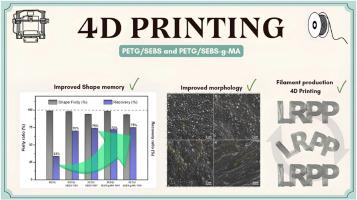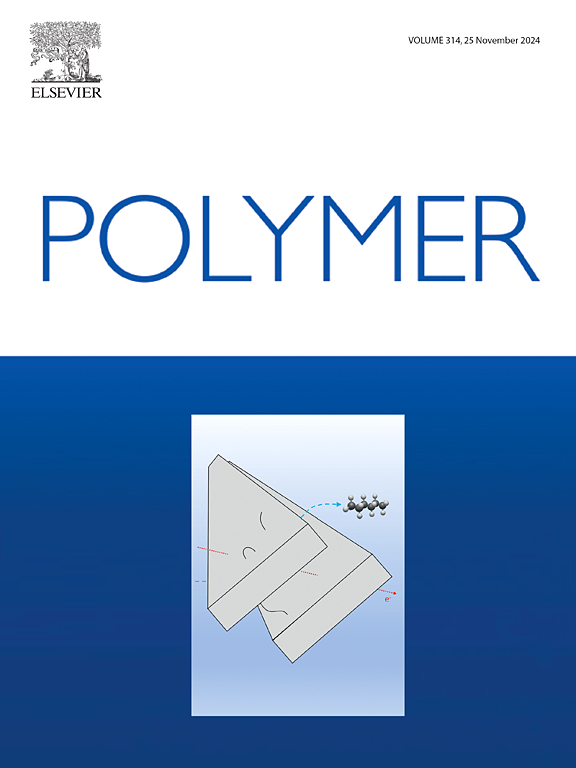PETG/SEBS共混物的4D打印行为:不同苯乙烯含量的反应性和非反应性SEBS的比较研究
IF 4.1
2区 化学
Q2 POLYMER SCIENCE
引用次数: 0
摘要
增材制造中对柔性和功能性材料的需求激发了对具有形状记忆能力的聚合物共混物的兴趣。PETG虽然广泛用于3D打印,但缺乏高级应用所需的灵活性。将SEBS弹性体,特别是与马来酸酐(SEBS-g- ma)接枝的弹性体掺入PETG基体中,可以提高弹性,同时引入形状记忆特性。本研究研究了通过熔融长丝制造(FFF)制备用于4D打印的PETG/SEBS和PETG/SEBS-g- ma共混物。FTIR和SEM分析表明,PETG/SEBS-g-MA共混物具有共连续的形貌,表明其具有良好的界面附着力,从而提高了力学性能和形状记忆性能。相比之下,PETG/SEBS共混物表现为海岛形态,相容性降低。SEBS中苯乙烯含量为13%的共混物具有较高的柔韧性,模量为2-5 MPa,伸长率超过230%,可制成柔软、有弹性的材料。在水中和通过流变学评估的形状记忆性能表明,所有混合物的恢复和固定性能接近100%,水激活恢复性能优于扭转测试。成功生产了直径1.6-1.8毫米的细丝,实现了4D打印应用。像PETG/SEBS-g-MA(30%苯乙烯)这样的共混物由于相容性的改善,表现出了优越的尺寸控制和打印便利性。总之,PETG/SEBS和PETG/SEBS-g- ma共混物在灵活性和形状记忆能力方面提供了显着改善,使其成为4D打印的理想候选者。优异的机械性能、高形状回复率和成功的长丝生产相结合,强调了它们在动态和自适应印刷结构中的应用潜力。本文章由计算机程序翻译,如有差异,请以英文原文为准。

4D Printing Behavior of PETG/SEBS Blends: A Comparative Study of Reactive and Non-Reactive SEBS with Varied Styrene Content
The demand for flexible and functional materials in additive manufacturing has spurred interest in polymer blends with shape memory capabilities. PETG, though widely used in 3D printing, lacks the flexibility required for advanced applications. The incorporation of SEBS elastomers, especially those grafted with maleic anhydride (SEBS-g-MA), into PETG matrices enhances flexibility while introducing shape memory properties. This study investigates PETG/SEBS and PETG/SEBS-g-MA blends prepared via fused filament fabrication (FFF) for 4D printing. FTIR and SEM analyses revealed a co-continuous morphology for PETG/SEBS-g-MA blends, indicating good interfacial adhesion, which improved mechanical properties and shape memory performance. In contrast, PETG/SEBS blends exhibited a sea-island morphology with reduced compatibilization. Blends with 13% styrene content in SEBS showed high flexibility, with modulus values of 2–5 MPa and elongations over 230%, producing soft, elastic materials. Shape memory performance, evaluated in water and via rheometry, demonstrated near-100% recovery and fixation for all blends, with water-activated recovery outperforming torsion tests. Filaments (1.6–1.8 mm diameter) were successfully produced, enabling 4D printing applications. Blends like PETG/SEBS-g-MA (30% styrene) showed superior dimensional control and printing ease due to improved compatibilization. In conclusion, PETG/SEBS and PETG/SEBS-g-MA blends offer a significant improvement in flexibility and shape memory capabilities, making them ideal candidates for 4D printing. The combination of excellent mechanical properties, high shape recovery, and successful filament production underscores their potential for use in dynamic and adaptive printed structures.
求助全文
通过发布文献求助,成功后即可免费获取论文全文。
去求助
来源期刊

Polymer
化学-高分子科学
CiteScore
7.90
自引率
8.70%
发文量
959
审稿时长
32 days
期刊介绍:
Polymer is an interdisciplinary journal dedicated to publishing innovative and significant advances in Polymer Physics, Chemistry and Technology. We welcome submissions on polymer hybrids, nanocomposites, characterisation and self-assembly. Polymer also publishes work on the technological application of polymers in energy and optoelectronics.
The main scope is covered but not limited to the following core areas:
Polymer Materials
Nanocomposites and hybrid nanomaterials
Polymer blends, films, fibres, networks and porous materials
Physical Characterization
Characterisation, modelling and simulation* of molecular and materials properties in bulk, solution, and thin films
Polymer Engineering
Advanced multiscale processing methods
Polymer Synthesis, Modification and Self-assembly
Including designer polymer architectures, mechanisms and kinetics, and supramolecular polymerization
Technological Applications
Polymers for energy generation and storage
Polymer membranes for separation technology
Polymers for opto- and microelectronics.
 求助内容:
求助内容: 应助结果提醒方式:
应助结果提醒方式:


